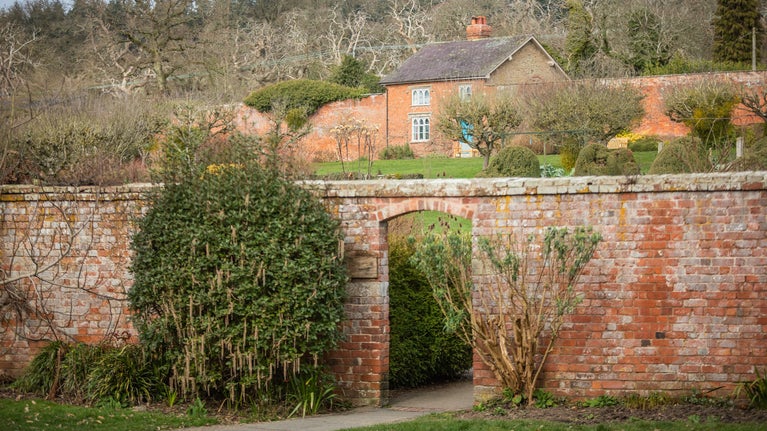
Discover more at Croft Castle and Parkland
Find out when Croft Castle is open, how to get here, things to see and do and more.

Be enchanted by the homely garden at Croft. Follow the sweeping border along the drive or sit and listen to the birds in the church garden. Look out for seasonal produce growing in the walled garden and discover some of the heritage apple varieties.
In spring, signs of life return to the garden with frogs and toads in the pond and blackbirds and thrushes singing in the mornings. Bumblebees and butterflies can also be spotted. In early spring snowdrops and crocuses flower, with daffodils to follow, filling the gardens with colour after a long winter's rest.
Follow the paths dating from 1823 around the walled garden to discover a variety of seasonal flowers all year round along with traditional and rare apple varieties. The garden also has a small vineyard, containing a variety of grape known as 'Phoenix'. It produces a white table wine that's refreshing and crisp to drink. According to the garden team, vines are a bit tricky to grow within a walled garden, requiring careful love and attention.
You'll find vegetable, fruit and salad borders, where fresh, seasonal produce is grown for visitors to enjoy in the Carpenters tea-room.
In the walled garden you'll also find the 1914 'J. Weeks and Co' glasshouse which has been completely restored by Croft's garden team. It involved taking out hundreds of panes of glass, stripping the old paint from the frame and repairing damaged sections before replacing the glass. The glasshouse is put to good use; growing a range of heritage variety tomatoes, cucumbers and peppers as well as new stock for the garden.

You can see where some of the Croft horses lived in the Georgian stable block. The carriage horse stalls are now home to the second-hand bookshop but some of the original hunter loose boxes remain today.
This 15th-century church is located next to the castle and within the garden, and is still used as a parish church. The garden team tend to the churchyard garden and if you take a look inside the church, you can see the tomb of Sir Richard Croft, who fought in the Battle of Mortimer’s Cross in 1461 during the Wars of the Roses. Parts of the church date from the 12th and 14th centuries and the original medieval tiled floor is a patchwork of the church's history.
The majority of the apple trees at Croft are thought to have been planted in the 1920s, judging by some of the archive photos. There is a collection of 60 mature specimens of around 30 cultivars. Old Herefordshire varieties at Croft include Adam’s Pearmain, Brown Snout, Doctor Hare, Downton Pippin, Gennet Moyle, King’s Acre Bountiful and Herefordshire Beefing.
In a field of about two acres near the farm at Croft there is a collection of very old apple trees, twisted with age but still productive. Some lie on their sides like wrecked ships and the smallish green apples with a red flush have an odd, somewhat ancient flavour of well-matured cider with a peppery aftertaste.
The paths in the garden are fully accessible to wheelchairs and pushchairs all year round. Dogs are allowed in the walled garden too, so you can see the vineyard and beautiful borders and stroll all the way around the castle.

Find out when Croft Castle is open, how to get here, things to see and do and more.

Croft Castle is a two pawprint rated place. You and your dog can explore 1,500 acres of parkland and beautiful gardens at Croft Castle.

Croft Castle was noted in the Domesday book in 1086 and the Croft family have played a part influencing British political and military history ever since. Uncover their stories in the castle.

Explore 1,500 acres of wood, farm and parkland including the 'Picturesque' Fishpool Valley and an Iron Age hillfort at Croft Castle.

Tuck into some lunch and light bites in the Carpenter’s tea-room at Croft Castle, or visit the second-hand bookshop to find yourself a pre-loved classic.

With over a thousand years of history, a cosy walled garden and 1,500 acres of parkland, there’s so much to discover and learn on a group visit.

From 18th-century water gardens and Arts and Crafts landscapes to intimate woodland gardens, there are so many places to discover.

Discover our gardeners’ top tips so you can make the most of your garden, plot or window box.

Discover veteran trees, sweeping parkland, historic orchards and river gardens, with exotic trees and vines that burst with colour throughout the year.